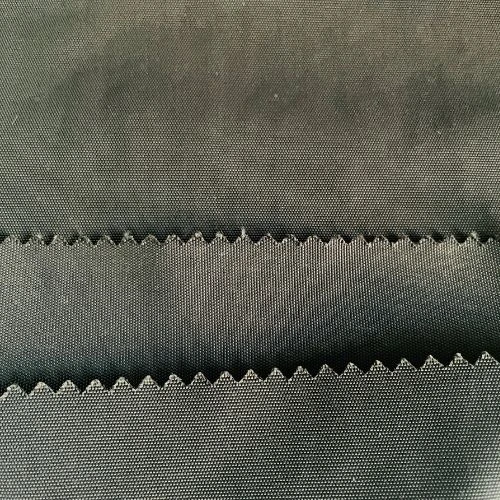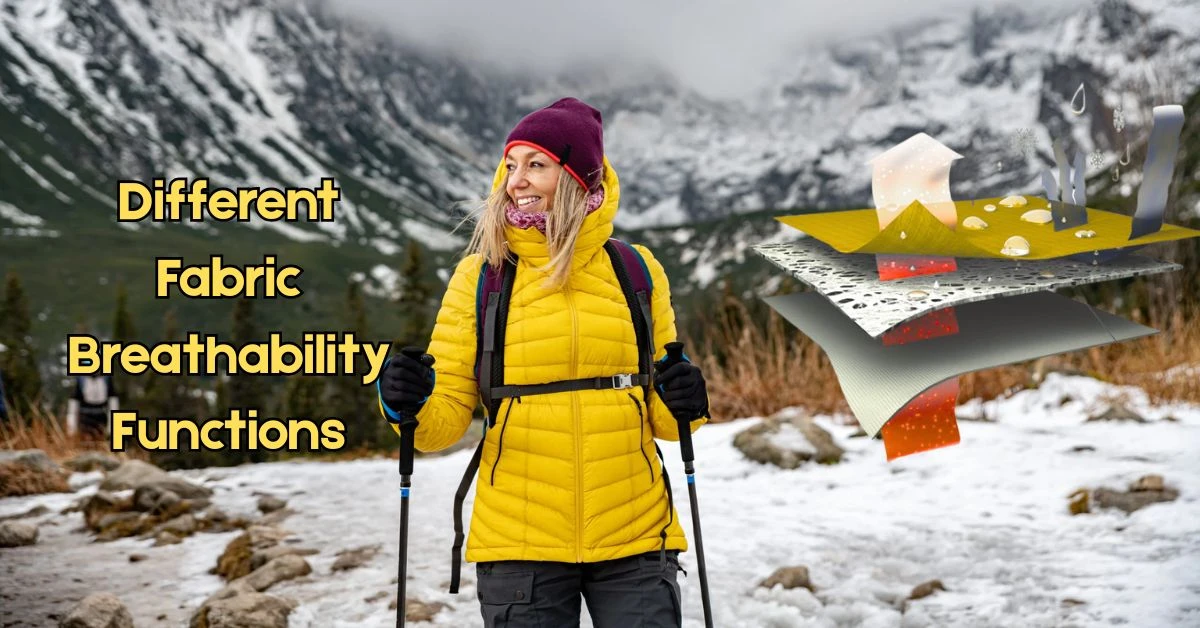|
Cordura Fabric |
Derived from “Cord” (referring to corded durability) and “ura” (shortened from polyurethane). |
|
Also Known As |
High-Tenacity Nylon Fabric, Nylon 6.6 Fabric |
|
Manufacturing Process |
High-Tenacity Fiber Spinning, Weaving, Coating, Finishing |
|
Appearance |
Matte, Rugged, Textured Surface; available in vibrant and subdued colors |
|
GSM Range |
200 GSM – 600 GSM |
|
Composition Range |
100% Nylon, Nylon/Polyester Blends |
|
Construction Range |
Twill Weave, Plain Weave, Ballistic Weave |
|
Functionality |
TPU, PU, PVC Coating, W/R (Water-Resistant), Flame Retardant, Anti-Abrasion |
|
Thread Density Range |
190T – 420T |
|
Count Variations |
210D, 420D, 500D, 1000D, 1050D |
|
Full Width |
57/58” or 59/60” |
|
Fabric Breathability |
Low to Moderate (depends on coatings and laminations) |
|
Moisture-Wicking Abilities |
Low (requires additional treatments for moisture-wicking) |
|
Heat Retention Abilities |
Moderate (varies with thickness and composition) |
|
Stretchability |
Minimal to None |
|
Prone to Pilling/Bubbling |
Highly resistant to pilling and bubbling |
|
Country Where First Produced |
United States (1929 by DuPont) |
|
Biggest Exporter Country |
China (Approx. 1.8 million metric tons per year) |
|
Recommended Washing Temperatures |
Cold to Warm (30°C to 40°C) |
|
Applications |
Backpacks, Outdoor Gear, Military Uniforms, Tactical Vests, Jackets, Denim, Automotive Upholstery |
Table Of Contents
What is Cordura Fabric?
The Cordura is a synthetic woven fabric made of high-strength nylon and polyester which is extremely durable and tear and abrasion resistant. Sometimes, it is a synthetic and cotton blend fabric or natural fibers. The most common weaving pattern used to construct Cordura is basket weave. It was first developed and trademarked in 1929 by the E.I. du Pont de Nemours and Company. Now it is owned by INVISTA.
Cordura fabric can be found in various weights, aesthetics, and construction. It is widely known for possessing a superior 4-way stretch ability without damaging the material. The textile of this fabric is premium, and its usage has expanded for more than 70 years. The fabric was mainly developed during World War II when it was used in tires. Now, Cordura is used in making over 40% of the bags in the bag market.
Types of Cordura Fabric
Common variants include:
- Cordura Classic: Made from 100% high-tenacity nylon.
- Cordura Ballistic: Twice as strong as standard nylon, designed for military-grade protection.
- Cordura Denim: Combines the ruggedness of Cordura with the comfort of denim.
Cordura comes in many types, and its density is primarily measured in Deniers. The lower the denier number, the less the weight of the fabric, but then the durability decreases. The two most common denier is 500D and 1000D Cordura. Cordura is manufactured mainly by authorized fabric companies worldwide in factories. The Cordura fabric has many versions to choose from, all of which have remarkable durability.

Cordura Classic Fabric - Manufactured with 100% high tenacity and survives just as well in some of the world’s harshest environments as it did 50 years ago.

Cordura Combat Wool Fabric – The fabric which delivers the comfort of wool along with the resistance and performance benefits of nylon.

Cordura Ultralite Fabric – This fabric is super lightweight, weighs less than 50 gm2, and is used to produce hot air balloons and parachutes.

Cordura Nyco Fabric – A lightweight fabric that helps keep moisture from sticking on the skin as it is fast drying. Also, a very long-lasting fabric with increased durability.

Cordura Denim Fabric – The fabric that helps jeans last much longer than pure cotton denims. Even after experiencing stress, it does not lose its strength.

Cordura H.P. Fabric - Water repellent and resistant to tears and abrasions. The fabric is also optimized for printing as it is made of textured polyester.

Cordura Truelock Fabric – Features a matte appearance and can lock in color. A strong material with high U.V. resistance.

Cordura Art Fabric – A lightweight and breathable material is featuring an open knit mechanism that allows air to pass through. Also offers laminate options for water repellency.
What is Cordura Made of?
The Cordura fabric is made up of mostly nylon and polyester. But it could be a blend of nylon with cotton or other natural fibers. Nylon is not a naturally occurring product as it is synthetic, so it is produced in laboratories. Cordura is created by weaving together a specific form of nylon, which is nylon 66. The nylon was not used to be dyed back in the day, but from 1970 onwards, it has been dyed.
- Yarn Production: Synthetic fibers are spun into high-strength yarns.
- Weaving: These yarns are woven into fabrics, with specific weaves chosen based on the application.
- Coating: Many variants receive water-resistant or flame-retardant coatings for added functionality.
Properties of Cordura Fabric:
|
Materials needed to manufacture |
Cordura is usually made up of nylon, or a blend of cotton or other natural fibers. |
|
Durability |
Efficiently durable with high functionality. |
|
Heat resistance levels |
Have a melting point of 254° which means it has a high resistance to heat. |
|
Breathability |
Highly breathable. |
|
Flexibility |
Offers four-way stretch, which makes the fabric very flexible. |
|
Most significant production happening |
In Taiwan. |
|
Is it Bulletproof? |
Depends on the blend of the material, but somewhat bulletproof. |
|
Moisture resistant abilities |
Water repellant coating to ensure dryness during rainy weather. |
|
Country to first manufacture it |
Delaware, USA. |
|
Frequency of needing to be dry cleaned |
It varies and depends on the substance that needs to be removed. |
|
Perfect washing temperature |
30°C in the washing machine. |
|
Wale variations of the fabric |
Anywhere between 1.5 to 2.1 |
Cordura Properties
Characteristics of Cordura Fabric
Some of the primal characteristics of the Cordura fabric include its weight and durability of this fabric. The fabric is made out of synthetic, so it is expected to last long. The fabric is made of fibers with high tensile strength, which can withhold long-term usage. It is also 100% waterproof, where the water forms up as beads and rolls off the fabric. Cordura is also low maintenance, so you don’t have to worry much about maintaining it.

Another fantastic characteristic of this fabric is that Cordura will not easily catch or spread fire, and it is also self-extinguishing due to its high heat resistance. The fabric does not shrink or change its texture, even in hot water. Cordura can stretch a lot without losing its previous shape and offers good breathability features. The density of this material varies from 100 to 1000 deniers, which means it is pretty dense. All of these make Cordura a pretty expensive and heavy fabric, but you will get more than what you paid.
Applications of Cordura Fabric
1. Outdoor Gear: Cordura is a staple in outdoor products like backpacks, tents, and hiking boots. It withstands wear and tear, making it ideal for extreme conditions.
2. Military and Tactical Uses: Used in uniforms, body armor, and tactical gear, Cordura Ballistic provides unmatched protection and resilience.
3. Fashion and Everyday Wear: From stylish jackets to durable jeans, Cordura fabrics are making waves in the fashion world. Cordura Denim, for example, gives you rugged durability with a modern look.
4. Automotive and Industrial Uses: Cordura is often used in seat covers, upholstery, and even conveyor belts. Its industrial-grade strength ensures long-lasting performance.
Where to Use the Cordura Fabric?
Cordura can be used in a wide range of products, and here is a list of the notable products where Cordura is used. Applications of Cordura fabric are as:
- Backpacks
- Workwear
- Luggage
- Military wear
- Trousers
- Tactical shoes
- Pants
- Tops
- Motorcycle jackets
- Briefcase
- Wallet
- Protective outerwear
- Footwear, etc
Frequently Asked Questions
Which one is better 500D or 1000D Cordura?
Actually, it depends on the end-use. All that you should know is that 500D Cordura is lighter than 1000D Cordura.
Can Cordura fabric be ironed?
Yes, use a warm iron and only press on the uncoated side.
Is Cordura expensive?
Cordura is an expensive fabric due to the many advantages and versatility it brings.
Can Cordura fabric be dyed?
Yes, it can be dyed using acid dyes and get the desired color; the fabric should be dyed in almost boiling water.
Is Cordura waterproof?
Cordura is entirely waterproof and also wicks off sweat.
Why is Cordura different from the rest of the fabrics?
Cordura is made up of a synthetic material that is known for its durability and lasts a long time. What separates it from the other fabrics is how Cordura can be used for many items and not change properties.
Final Words:
Cordura is a fabric that is widely known for having many outstanding properties. Its durability and longevity have enabled the fabric to be used in many items. Cordura offers many advantages and looks unique on the different items it uses. This fabric has been around for quite a long time, as it was used in World war II, but it is still unknown to some people.













Comments - 00
Leave A Reply
Thanks for choosing to leave a comment.